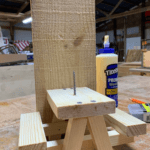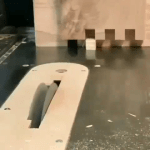Duct tape residue can be an incredibly stubborn problem to deal with, especially when it comes to woodwork. The adhesive used in duct tape is strong and durable, making it incredibly effective for its intended purpose. However, when the tape is removed, it often leaves behind a sticky residue that can be quite challenging to remove from wood surfaces. It’s important to approach this task with care to avoid causing further damage to the woodwork.
Removing duct tape residue from woodwork can be difficult due to the porous nature of wood surfaces. The adhesive tends to seep into the grain of the wood, making it even more stubborn and resistant to regular cleaning methods. Additionally, some scrapers or cleaning agents may contain harsh chemicals that can damage or discolor the wood if not used properly.
Taking precautionary measures and using gentle techniques will help ensure successful removal without causing harm. Before attempting any removal method, it’s crucial to identify the type of woodwork you’re working with as different types may require specific techniques or solvents for effective residue removal.
By being mindful and following proper steps, you can safely remove duct tape residue from your cherished wooden furniture, cabinets, or trim without damaging their natural beauty. In the next sections of this article, we will dive deeper into understanding different types of woodwork and how they may affect removal techniques, as well as preparation steps and gentle methods you can use for successful residue removal while protecting your valuable wood surfaces.
Understanding the Types of Woodwork
Woodwork is a common feature in many households, whether it’s in the form of furniture, cabinets, or trim. However, when duct tape is used on wood surfaces and removed, it often leaves behind a sticky residue that can be quite challenging to get rid of. Before attempting to remove duct tape residue from woodwork, it’s important to understand the different types of woodwork and how they may require varying techniques for residue removal.
When it comes to removing duct tape residue, different types of woodwork may react differently to certain removal methods. For example, hardwood furniture may be more resistant to damage than delicate trim or veneered surfaces. By identifying the type of woodwork you’re dealing with, you can tailor your approach accordingly and minimize the risk of causing any unintended harm.
Before diving into the removal process, proper preparation is key. Gather all the necessary materials and tools that you will need such as rubbing alcohol or non-abrasive cloth. It is crucial to prepare the work area as well by covering surrounding surfaces or using protective barriers to prevent spreading residue or causing further damage.
Additionally, ensure that the woodwork is clean and dry before beginning the removal process. This will help optimize the effectiveness of your chosen method and eliminate any additional obstacles that could hinder your progress. Taking these initial steps will set you up for success when removing duct tape residue from woodwork without compromising its integrity.
Identifying Different Techniques for Each Type of Woodwork
Different types of woodwork call for specific techniques when removing duct tape residue. For example:
- Hardwood furniture: A hairdryer on low heat settings can be effective at loosening adhesive without damaging the surface.
- Cabinets: Natural solvents like olive oil or coconut oil can be applied to soften and dissolve the residue.
- Trim: Rubbing alcohol or acetone can be used with caution, as these substances are more potent and should only be used sparingly on delicate surfaces.
By understanding the nuances of each type of woodwork, you can choose an appropriate technique and minimize any potential damage while effectively removing duct tape residue. Always proceed with caution and perform a spot test on an inconspicuous area before applying any method to the entire wood surface.
Preparing the Woodwork
Before attempting to remove duct tape residue from woodwork, it is important to properly prepare the surface to ensure successful removal without causing any further damage. This section will guide you through the initial steps that are crucial for achieving optimal results.
The first step in preparing the woodwork is to gather all the necessary materials and tools. You will need rubbing alcohol or acetone, a non-abrasive cloth or sponge, a plastic scraper, and a clean towel or rag. It is important to note that different types of wood may respond differently to certain substances, so it is recommended to test any solvent on a small, inconspicuous area of the woodwork before proceeding with the removal process.
In addition to gathering materials, it is essential to prepare the work area itself. Clear away any objects or debris that may obstruct your access to the woodwork. Lay down a protective covering such as plastic or old newspapers to catch any residue that may fall during removal. This will prevent further mess and make cleanup easier afterward.
Finally, before you start removing the duct tape residue, ensure that the woodwork is clean and dry. Remove any dust or dirt using a soft brush or cloth. If there are any stains or spills on the surface, use a mild soap and water solution to gently clean them off. Allow sufficient time for the wood surface to completely dry before proceeding with the removal process.
By following these initial steps of properly preparing your woodwork, you will set yourself up for success in removing duct tape residue without causing harm or further damage. Taking these precautions will help ensure an effective and efficient removal process while safeguarding the natural beauty of your wood surfaces.
Gentle Removal Techniques
Duct tape residue can be a stubborn problem on woodwork, but with the right techniques, it can be safely removed without damaging the surface. This section will explore gentle removal techniques that can effectively tackle duct tape residue on woodwork.
One method for removing duct tape residue from woodwork is by using heat to loosen the adhesive. This can be done using a hairdryer or a heat gun on low settings. To methodically remove the residue, hold the heat source a few inches away from the surface and gradually move it back and forth over the affected area.
As the adhesive heats up, it will become softer and easier to remove. It’s important to exercise caution and avoid overheating or scorching the wood surface.
Another effective method for removing duct tape residue is utilizing natural solvents. Household items such as olive oil or coconut oil can be applied directly to the residue. Allow it to sit for a few minutes before gently rubbing it with a soft cloth or sponge. The natural oils will help break down the adhesive and make it easier to remove without damaging the woodwork.
Rubbing alcohol or acetone can also be used for removing stubborn duct tape residue from woodwork. These substances have properties that break down adhesives effectively. It’s crucial to apply them sparingly with a non-abrasive cloth, as excessive use may cause damage. Always test these solvents on an inconspicuous area of the woodwork first before applying them to larger sections.
To summarize, gentle removal techniques are effective in safely tackling duct tape residue on woodwork. Whether through using heat, natural solvents, or rubbing alcohol/acetone, taking care not to damage the wood surface is key. By following these methods carefully, it is possible to successfully remove even stubborn residues without leaving any marks behind.
| Removal Technique | Benefits |
|---|---|
| Using heat | Loosens adhesive for easier removal |
| Utilizing natural solvents | Effectively breaks down adhesive without damaging wood |
| Applying rubbing alcohol or acetone | Breaks down adhesive and can be applied sparingly |
Gentle Scrubbing Techniques
Removing stubborn duct tape residue from woodwork can be a challenging task, but with the right techniques, it is possible to achieve a clean surface without causing damage. Gentle scrubbing techniques are an effective way to break down and remove the residue while preserving the integrity of the wood.
Before starting the scrubbing process, gather the necessary materials and tools. You will need a non-abrasive cloth or sponge, rubbing alcohol or liquid dish soap, and some warm water. Ensure that your work area is well-prepared by laying down a protective barrier to avoid further damage to the woodwork.
To begin removing the residue, dampen your cloth or sponge with rubbing alcohol or a mixture of liquid dish soap and warm water. Gently rub the affected area in circular motions, applying light pressure. This will help break down the adhesive and loosen any stubborn residue.
Be sure to maintain a steady hand and avoid using excessive force while scrubbing. Using too much pressure or abrasive cloths can cause scratches on the wood surface. If necessary, you can gently scrape away any particularly stubborn residue with a plastic scraper.
After scrubbing away the residue, rinse the area with clean water and dry it thoroughly with a soft towel. Inspect the woodwork to ensure that no residue remains before moving on to polishing and restoring it.
By following these gentle scrubbing techniques, you can effectively remove stubborn duct tape residue from woodwork without causing harm. Remember to always test any cleaning solution on an inconspicuous area of the woodwork first to ensure that it does not cause any damage or discoloration. With patience and care, you can restore your wood surfaces to their natural beauty.
Polishing and Restoring the Woodwork
Using Wood-Specific Cleaners or Polishes
After successfully removing the duct tape residue from your woodwork, it is important to take steps to restore its natural shine and beauty. One effective way to accomplish this is by using wood-specific cleaners or polishes. These products are specifically formulated to enhance the appearance of wood surfaces and protect them from future damage.
When choosing a wood cleaner or polish, it is essential to select one that is compatible with the type of woodwork you have. Different woods may have different requirements for cleaning and polishing, so it is important to read the labels carefully before making a purchase.
To apply the cleaner or polish, start by cleaning the surface with a soft cloth or sponge and warm water. This will remove any dirt or residue that may be on the woodwork. Once the surface is clean and dry, apply a small amount of the cleaner or polish onto a clean cloth and gently rub it into the wood in circular motions. Be sure to follow any specific instructions provided by the manufacturer.
Recommendations on Restoring Woodwork’s Natural Beauty
In addition to using wood-specific cleaners or polishes, there are other recommendations you can follow to restore your woodwork’s natural beauty:
- Sanding: If there are any rough spots or imperfections on the wood surface, lightly sand them using fine-grit sandpaper until they are smooth. Be careful not to sand too aggressively as this can damage the wood.
- Staining: If your woodwork has lost its color or requires a refreshment, staining can be an effective option. Choose a stain color that matches your existing finish or enhances its appearance. Apply the stain according to the manufacturer’s instructions and allow it to dry completely before moving on.
- Applying Sealant: To provide extra protection against future residue buildup and damage, consider applying a clear sealant over the woodwork. This will create a barrier that prevents moisture and dirt from penetrating the wood surface.
Protecting Woodwork from Future Residue
To avoid dealing with duct tape residue on your woodwork in the future, it is important to take preventative measures. Here are some tips for protecting your wood surfaces:
- Use alternative methods for securing items: Instead of relying solely on duct tape, consider using other methods such as Velcro, adhesive hooks, or clamps to secure items temporarily to your woodwork. These alternatives are less likely to leave behind sticky residue.
- Utilize protective barriers or coverings: Before introducing any adhesives onto your woodwork, consider applying a protective barrier such as wax paper or plastic wrap. This will create a barrier between the adhesive and the wood surface, making it easier to remove without leaving residue.
By following these steps for restoring and protecting your woodwork, you can ensure that it remains in great condition and free from duct tape residue for years to come.
Preventing Duct Tape Residue on Woodwork
Duct tape residue on woodwork can be a frustrating and stubborn problem. However, there are steps you can take to prevent this issue from occurring in the first place. By implementing these preventative measures, you can save yourself the hassle of having to remove sticky residue from your wood surfaces.
One effective method for preventing duct tape residue is to explore alternative methods for temporarily securing items to woodwork. Instead of relying solely on duct tape, consider using hooks, brackets, or adhesive strips specifically designed for use on wood surfaces. These alternatives provide a secure hold without leaving behind any sticky residue when removed.
Another approach to preventing duct tape residue is to utilize protective barriers or coverings on the wood surface before applying any adhesives. For example, you can use parchment paper or plastic wrap as a protective layer between the wood and the tape. This creates a barrier that prevents the adhesive from directly contacting the wood surface and causing residue buildup.
Regular maintenance and cleaning of your woodwork can also help prevent duct tape residue. By keeping the surface clean and free of dirt and debris, you reduce the chances of adhesive sticking more firmly to the wood. Additionally, inspecting your woodwork regularly allows you to address any issues promptly before they worsen and require more aggressive removal methods.
Troubleshooting
If despite your best efforts, the duct tape residue persists or causes damage to the woodwork, there are a few troubleshooting steps you can take to address the issue.
- Evaluate the severity of the residue: If the residue is minor and only affecting a small area, you may want to consider repeating the removal techniques discussed earlier in the article. Sometimes multiple attempts are needed for stubborn residue. However, if the residue is extensive or deeply embedded, it may be time to seek professional help.
- Seek professional assistance: If your efforts have been unsuccessful or if you’re dealing with delicate or expensive woodwork, it’s advisable to consult a professional who specializes in wood restoration. They will have specialized tools and techniques to eliminate tough residues without causing further damage.
3. Assess any damage caused by removal attempts: If your attempts at residue removal have inadvertently caused damage to the woodwork such as scratches or discoloration, don’t panic. There are ways to address these issues as well:
- Scratches: For minor scratches on finished wood surfaces, you can try using a scratch repair marker or touch-up pen that matches the color of your woodwork. Apply it carefully and follow instructions for blending it into the surrounding area. For deeper or more severe scratches, it’s best to consult a professional for repair options.
- Discoloration: If there is discoloration from chemical solvents or heat used during removal attempts, there are a few things you can try. Lightly sanding the affected area with fine-grit sandpaper and then applying an appropriate stain or finish can help restore uniformity. However, if this doesn’t yield satisfactory results, consulting a professional is recommended.
Remember that prevention is key when it comes to avoiding damage caused by duct tape residue on woodwork. Taking precautions such as using alternative methods of securing items and utilizing protective barriers will help minimize future headaches.
By following these troubleshooting steps and seeking professional help when needed, you can ensure that your woodwork remains in excellent condition even after dealing with stubborn duct tape residue.
Conclusion
In conclusion, removing duct tape residue from woodwork can be a challenging task, but armed with the knowledge gained in this article, you can approach it confidently and effectively. We have discussed the various types of woodwork commonly found in households and how different techniques may be required to remove residue from each type. It is crucial to identify the type of woodwork before attempting any removal method to avoid causing damage.
Preparing the woodwork properly before starting the removal process is essential for successful residue removal. This includes gathering the necessary materials, such as rubbing alcohol and non-abrasive cloths, and ensuring that the work area is clean and dry. Taking these initial steps will help prevent further damage and spreading of residue.
We have also discussed gentle removal techniques using heat, natural solvents, rubbing alcohol or acetone, and gentle scrubbing techniques using non-abrasive cloths or sponges. Following the step-by-step instructions provided for each method and taking precautions will allow you to safely remove stubborn residue without causing harm to the wood surface.
After successfully removing duct tape residue, it is important to polish and restore the woodwork to bring back its shine. Using wood-specific cleaners or polishes will help protect it from future residue while enhancing its natural beauty. Additionally, we have explored tips for preventing duct tape residue on woodwork in the future by considering alternative methods for temporarily securing items or utilizing protective barriers.
Remember that troubleshooting may be necessary if the residue persists or causes damage during the removal process. However, with perseverance, patience, and possibly seeking professional help for severe cases, you can overcome any challenges that arise.
Armed with these insights and strategies, I encourage you to tackle duct tape residue on your woodwork confidently. By following these guidelines carefully, you can restore your wood surfaces to their former glory while avoiding any unnecessary damage. Good luck.
Frequently Asked Questions
How do you remove dried duct tape residue?
To remove dried duct tape residue, there are a few effective methods you can try. Start by applying heat to the residue using a hairdryer or heat gun on low setting. The heat will soften the adhesive, making it easier to remove. Then, gently scrape off the softened residue using a plastic scraper or an old credit card.
Another option is to apply a solvent like rubbing alcohol, vinegar, or nail polish remover onto the residue and allow it to sit for a few minutes. Afterwards, use a clean cloth to rub away the sticky residue. If the residue persists, repeat these steps until it is completely removed.
How do you remove duct tape residue without removing paint?
When removing duct tape residue without removing paint, it’s important to be cautious and use gentle methods. Begin by dabbing some vegetable oil or olive oil onto a clean cloth and gently rubbing it over the sticky area. The oil helps loosen the adhesive without harming the paintwork.
Afterward, wipe away any remaining residue with warm water and mild soap, making sure not to scrub too hard. For stubborn residues, try applying a small amount of baking soda mixed with water on a damp cloth and gently rub it over the sticky spot before rinsing thoroughly.
How do you get sticky residue off wood?
Getting sticky residue off wood surfaces may require different approaches depending on the severity of the stickiness and type of wood involved. One method is to create a paste using equal parts baking soda and water then apply it directly onto the sticky area. Allow this mixture to sit for several minutes before gently scrubbing it away with a soft sponge or cloth dipped in warm water.
Alternatively, you can use dish soap mixed with warm water as a cleaning solution by gently wiping down the wooden surface with it until all sticky residues are gone; be cautious not to soak or excessively wet the wood surface during this process as excess moisture can cause damage over time. For more delicate and valuable wooden items, using specialized wood cleaners available in stores might be recommended to ensure proper care and maintenance of the wood.

Hi everyone! I’m a woodworker and blogger, and this is my woodworking blog. In my blog, I share tips and tricks for woodworkers of all skill levels, as well as project ideas that you can try yourself.





